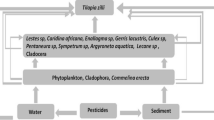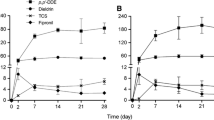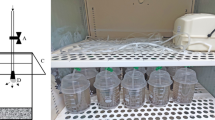Abstract
Agricultural pesticide runoff in southeastern coastal regions of the United States is a critical issue. Bioconcentration of pesticides by phytoplankton and zooplankton at the base of the aquatic food web may increase the persistence of pesticides in aquatic ecosystems and cause effects at higher trophic levels. This study examined the toxicity of a widely used agricultural pesticide, endosulfan, to Pseudokirchneriella subcapitatum (freshwater green alga) and Daphnia magna (freshwater cladoceran). We then investigated the potential of both plankton species to sequester endosulfan from their surrounding media. We also assessed the degree to which endosulfan is accumulated by D. magna via food (endosulfan-contaminated P. subcapitatum). A 96-h growth rate EC50 of 427.80 μg/L endosulfan was determined for P. subcapitatum, whereas a 24-h immobilization EC50 of 366.33 μg/L endosulfan was determined for D. magna. The 5-h EC50s for filtration and ingestion in D. magna were 165.57 μg/L and 166.44 μg/L, respectively. An average bioconcentration factor (BCF) of 2,682 was determined for P. subcapitatum exposed to 100 μg/L endosulfan for 16 h. An average BCF of 3,278 was determined for D. magna in a 100 μg/L endosulfan water-only exposure. There was negligible uptake of endosulfan by D. magna feeding on contaminated algae in clean water (BCF ∼ 0). Different proportions of parent isomers (endosulfan I and II) and the primary degradation product (endosulfan sulfate) were detected among treatments. Endosulfan was rapidly accumulated and concentrated from water by P. subcapitatum and D. magna neonates. Endosulfan contained in phytoplankton, however, was not bioaccumulated by zooplankton. These findings may prove useful in assessing ecosystem risk, because uptake from the water column appears to be the dominant route for bioconcentration of endosulfan by zooplankton.
Similar content being viewed by others

Author information
Authors and Affiliations
Additional information
Received: 30 January 2001/Accepted: 26 August 2001
Rights and permissions
About this article
Cite this article
DeLorenzo, M., Taylor, L., Lund, S. et al. Toxicity and Bioconcentration Potential of the Agricultural Pesticide Endosulfan in Phytoplankton and Zooplankton. Arch. Environ. Contam. Toxicol. 42, 173–181 (2002). https://doi.org/10.1007/s00244-001-0008-3
Issue Date:
DOI: https://doi.org/10.1007/s00244-001-0008-3



